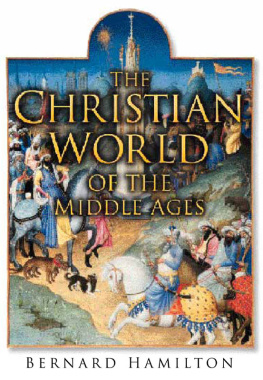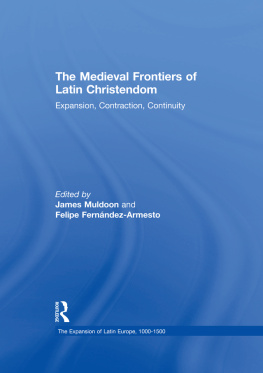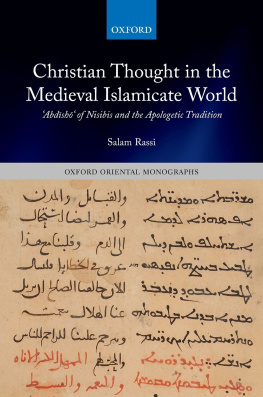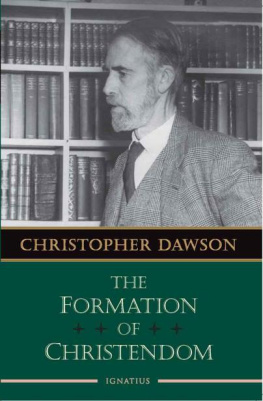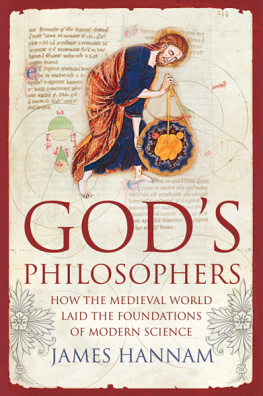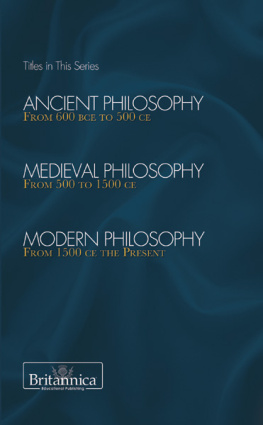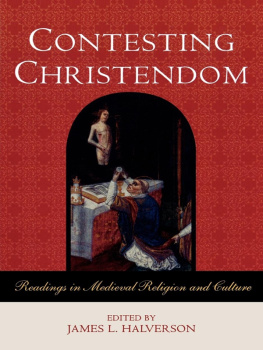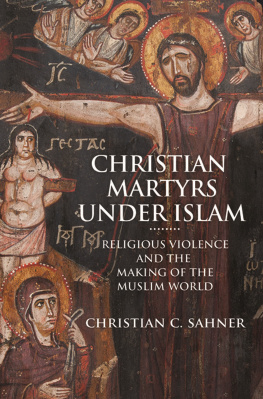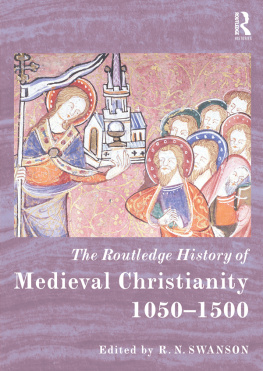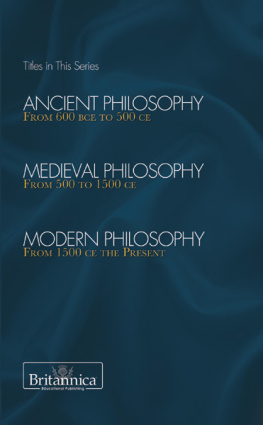Bernard Hamilton - Christian World of the Middle Ages
Here you can read online Bernard Hamilton - Christian World of the Middle Ages full text of the book (entire story) in english for free. Download pdf and epub, get meaning, cover and reviews about this ebook. year: 2003, publisher: The History Press, genre: Religion. Description of the work, (preface) as well as reviews are available. Best literature library LitArk.com created for fans of good reading and offers a wide selection of genres:
Romance novel
Science fiction
Adventure
Detective
Science
History
Home and family
Prose
Art
Politics
Computer
Non-fiction
Religion
Business
Children
Humor
Choose a favorite category and find really read worthwhile books. Enjoy immersion in the world of imagination, feel the emotions of the characters or learn something new for yourself, make an fascinating discovery.
- Book:Christian World of the Middle Ages
- Author:
- Publisher:The History Press
- Genre:
- Year:2003
- Rating:5 / 5
- Favourites:Add to favourites
- Your mark:
- 100
- 1
- 2
- 3
- 4
- 5
Christian World of the Middle Ages: summary, description and annotation
We offer to read an annotation, description, summary or preface (depends on what the author of the book "Christian World of the Middle Ages" wrote himself). If you haven't found the necessary information about the book — write in the comments, we will try to find it.
Christian World of the Middle Ages — read online for free the complete book (whole text) full work
Below is the text of the book, divided by pages. System saving the place of the last page read, allows you to conveniently read the book "Christian World of the Middle Ages" online for free, without having to search again every time where you left off. Put a bookmark, and you can go to the page where you finished reading at any time.
Font size:
Interval:
Bookmark:
THE
CHRISTIAN
WORLD
OF THE
MIDDLE AGES
In memory of
Fr. W.R. Corbould
WORLD
MIDDLE AGES
BERNARD HAMILTON

First published in 2003 by Sutton Publishing
The History Press
The Mill, Brimscombe Port
Stroud, Gloucestershire, GL5 2QG
www.thehistorypress.co.uk
This ebook edition first published in 2013
All rights reserved
Bernard Hamilton, 2003, 2013
The right of Bernard Hamilton to be identified as the Author of this work has been asserted in accordance with the Copyrights, Designs and Patents Act 1988.
This ebook is copyright material and must not be copied, reproduced, transferred, distributed, leased, licensed or publicly performed or used in any way except as specifically permitted in writing by the publishers, as allowed under the terms and conditions under which it was purchased or as strictly permitted by applicable copyright law. Any unauthorised distribution or use of this text may be a direct infringement of the authors and publishers rights, and those responsible may be liable in law accordingly.
EPUB ISBN 978 0 7524 9476 0
Original typesetting by The History Press
T he period covered by this book, 3001500, represents more than half the lifespan of the Christian religion. During those centuries not only did it become the dominant faith of Western Europe, but also spread north-west to the Viking settlements in Iceland and Greenland as well as north-east, from the Byzantine Empire to the peoples of Russia. In Egypt, north Africa and the Near East, the early success of Christianity was tempered from the mid-seventh century by the foundation of the Islamic Arab Empire, which stretched from the Indus Valley to Morocco. In all those lands which remained under Islamic rule throughout the Middle Ages Christianity either died out or became a minority religion, though that process took centuries to complete; but beyond the Islamic frontiers in Africa and Asia there were flourishing Christian societies in this period. These were found within the Chinese Empire, among the nomadic peoples of Mongolia and Central Asia, in the Hindu states on the Malabar coast of South India, in the Nubian kingdoms which spanned the Nile to the south of Philae, in the Empire of Ethiopia and in the Caucasian kingdoms of Armenia and Georgia.
A great deal has been written in English about the medieval Western Church, and a substantial amount about Byzantium and its cultural heirs in the Balkans and Russia, and there are also some, though rather fewer, studies of the oriental and African churches. To my knowledge there is not any single general history written in English of the Church throughout the world in the medieval centuries, and it is that gap which I have tried to fill.
I have taken as my starting point the decision made in 312 by Constantine the Great to make Christianity a lawful religion in his empire. This marked the end of the age of persecutions and allowed the Church to develop freely as part of Roman society. I conclude the study in c. 1500, by which time the Western European powers had developed the capacity to travel to most parts of the world by sea. This enabled them to found overseas dominions in which they established the Christian Church in its Western form initially Latin Catholic, but later, in the case of the Dutch and the British, Protestant. This occurred even in areas like South India where an organized Christian community already existed. This Western religious imperialism marks a significant break with the medieval world in which a great many different types of Christianity had flourished in Asia and Africa.
A brief explanation of the nomenclature used in this book may be helpful. The term Catholic Church is reserved for the undivided Church of the fourth century from which most of the other medieval Churches traced their origins. I have sometimes referred to the medieval Western Church as the Western Catholic Church, but more frequently as the Latin Catholic Church, because of the liturgical language which it used. I have avoided the term Roman Catholic because it implies that the Church was dominated by the Papacy to a degree which only happened after the Council of Trent.
I have used the term Orthodox to describe those Churches which accept the authority of the first Seven General Councils: this applies to the Patriarchate of Constantinople and those Churches which are in full communion with it. An important group of Churches rejected the Council of Chalcedon (451) and therefore also the later Councils recognized by the Orthodox Churches. Collectively these Churches may be described as non-Chalcedonian, but this is a term I have seldom needed to use, and I have called the constituent Churches in this group by their customary names: the Armenian Church, the Coptic Church (of Egypt) and the Ethiopian Church. However, I have described one Church in that group, the Syrian Orthodox Church, in an old-fashioned way, as the Jacobite Church. I do not intend any disrespect by this usage; my sole reason for adopting it is to avoid the difficulty which might otherwise be experienced by readers in distinguishing between this Church and the Orthodox Church in Syria (i.e. those people in communion with the Orthodox Patriarch of Antioch). The name Jacobite comes from Bishop Jacob Baradaeus, who first gave that Church an organization independent of the Chalcedonian hierarchy.
The principal Church in Asia in the Middle Ages was headed by the Patriarch of SeleuciaCtesiphon. Its members call it the Church of the East, and I have used this name, but this raises a technical problem, because this name has no adjectival form. I have therefore used the word Chaldean to describe members of this Church and as a general-purpose adjective for everything relating to it. Chaldean was the term used by medieval Western writers when referring to this Church. By Chaldean they meant Syriac, the liturgical language of the Church of the East, and it therefore seemed an appropriate term for me to adopt.
All the dates in this book relate to the Christian era, unless otherwise specified.
I have spent much of my adult life teaching, reading and writing about medieval Christendom, and therefore the number of scholars who have made it possible for me to write this book and to whom I should like to express my thanks is considerable. First, I owe to the late Dom David Knowles such understanding as I have of the importance of the Benedictine tradition and of twelfth-century Christian humanism in the shaping of Western Christendom. I am indebted to Professor Joan Hussey for awakening in me what has proved to be a lifelong interest in the Byzantine world and the Orthodox Church. The late Fr. Jean Leclercq, with his broad human sympathies, did much to make the monastic centuries and their thought-world come alive for me. The conversation and writings of Peter Brown have been a source of stimulation throughout my life, encouraging me to think of Christian history in the widest possible cultural, intellectual and religious context, an approach which has proved very relevant to the present study. The late Fr. Joseph Gill helped me to appreciate how remarkable was the achievement of the Council of Florence (143744) when, for the only time in Christian history, all the Churches were briefly united. George Every has enriched my understanding of the complexity of Byzantine Orthodoxy and the need to examine it not only from the viewpoint of Constantinople, but also from that of Alexandria, Antioch, Calabria and Kiev. I am deeply indebted to my friend Charles Beckingham for guiding me through the labyrinth of Prester John studies and for helping me to understand the civilization of Ethiopia. I should like to express my thanks to David Morgan and Peter Jackson for elucidating the place which Christianity occupied in the Mongol Empire. I am grateful to Kevork Hintlian and to Grard Ddyan for important insights they have provided into the civilization of medieval Armenia. Andrew Palmer has been of great help in elucidating the early history of the Syrian Orthodox/Jacobite Church, while Jean Richard, through his wide-ranging studies has illuminated the whole field of medieval Western relations with the Churches of Africa and Asia. John Wilkinson and Denys Pringle have proved invaluable guides to the pilgrim literature and archaeological evidence concerning Jerusalem and its unique place in the medieval Christian world. Finally, I wish to express my thanks to the late Fr. W. Robert Corbould, who was my parish priest when I was in my teens and who first made me aware of the rich diversity of the Christian medieval tradition, and it is to him that I dedicate this work.
Next pageFont size:
Interval:
Bookmark:
Similar books «Christian World of the Middle Ages»
Look at similar books to Christian World of the Middle Ages. We have selected literature similar in name and meaning in the hope of providing readers with more options to find new, interesting, not yet read works.
Discussion, reviews of the book Christian World of the Middle Ages and just readers' own opinions. Leave your comments, write what you think about the work, its meaning or the main characters. Specify what exactly you liked and what you didn't like, and why you think so.

